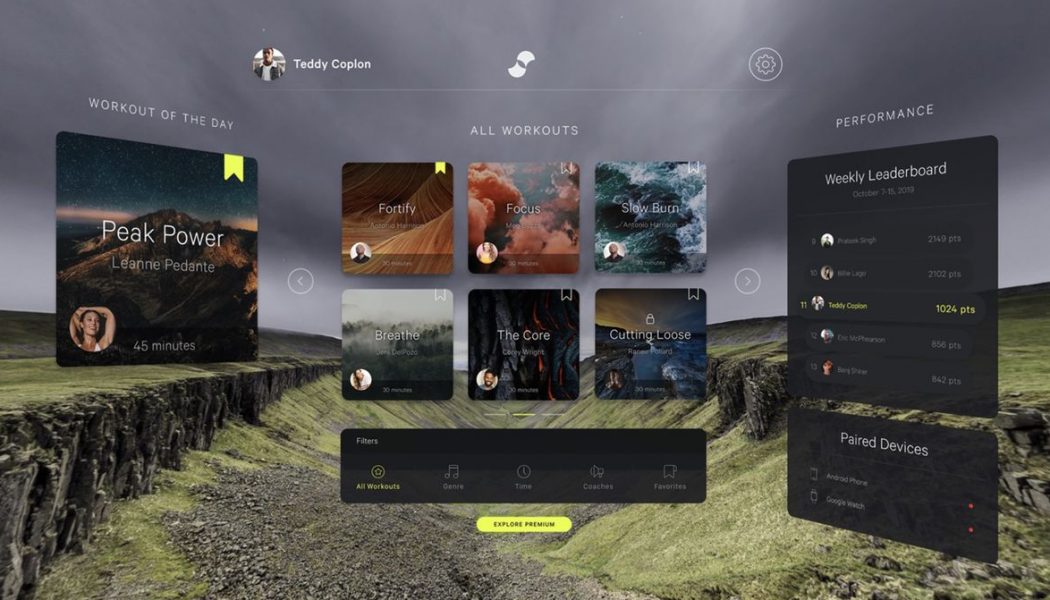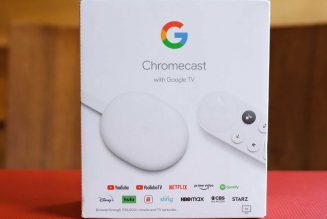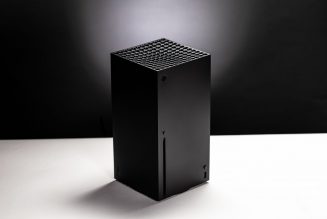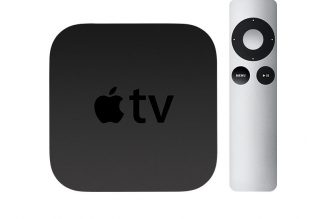For obvious reasons, the interest in working out at home has never been higher. Whether you’re doing yoga with Adriene, working your way through Ring Fit Adventure, or scouring Amazon for a spin bike that’s in stock, you’ve probably been looking for ways to keep active without leaving the house. Me? I’ve been using VR. And a new product called Supernatural is one of the more compelling at-home workouts I’ve tried so far.
To use a reductive comparison, Supernatural is sort of like Beat Saber meets Peloton. You use motion controllers to bash blocks coming towards you in time to the music, like countless other VR rhythm games. But Supernatural also uses curated workouts, choreographed patterns, and human instructors who are with you all the way, encouraging you to push harder and explaining how to get the most out of your body movements. And rather than transporting you to a Tron-like environment with aggressive EDM blasting in your ears, you’re working out to gym-friendly mainstream hits in chill photorealistic natural settings.
Supernatural also sets itself apart with a controversial and unprecedented business model: the service is currently exclusive to the Oculus Quest and requires a $19.99 monthly subscription fee after a 30-day free trial.
This is clearly an ambitious product, and it wouldn’t be priced that way if its creators didn’t believe in its quality. Supernatural is developed by Within, a VR company that has been around since the early days of the technology’s current wave. It’s best known for its self-titled Within app, which is a popular hub for 360-degree cinema, and the company’s interactive work is regularly shown at film festivals.
[embedded content]
“One of the things we were noticing when creating projects was they had a bunch of intrinsic attributes, like time flies by — you end up getting lost in the fun of what you’re up to,” Within co-founder Aaron Koblin tells me over Zoom. “And you end up coming out of it out of breath, laughing and having a great time. At the same time we were buying Pelotons and experimenting with home fitness and exercise, and to be perfectly candid, none of it was fun. It was trying to distract you from doing something that is good for you but like, fundamentally not entertaining. So it didn’t take long before we were starting to put two and two together: that this medium is particularly well-suited to getting you to move your body in exciting, fun ways and that there could be a real value crafting something intentionally in that space.”
“There’s ways to get exercise that are fun that existed in the world before virtual reality,” adds co-founder Chris Milk. “Things like skiing or snowboarding or mountain biking or playing soccer with your friends. But you don’t think of those things as exercise necessarily, or fitness. You think of them as sports. But they work in the same way and they can still give you a great workout — except you’re never on the snowboard run thinking ‘Why do I have to do another squat?’ The exercise comes out of the fun activities that you’re doing, and what we saw when we started exploring all these different home fitness solutions was there just wasn’t anything that felt fun.”
Supernatural is fun. That shouldn’t be a surprise because it’s clearly inspired by VR rhythm games that came before it — as its creators freely admit — and it’s pretty well-established by now that it’s fun to hit virtual objects in time to music. “We looked at all of them,” says Milk. “We were playing AudioShield at the very beginning and we’ve obviously spent plenty of time in all of them, we love them all, and they really did help inform how there’s a potential for cardio exercise in virtual reality.”
:no_upscale()/cdn.vox-cdn.com/uploads/chorus_asset/file/19957931/sn4.jpg)
The next step was finding a design that would work as regular exercise rather than a traditional game structure. “We did a lot of experimentation and quite candidly, there’s only so many more ways we can build a beat game,” Milk says. “Things are gonna come at you and you’re going to hit them with something in either hand.” Other VR music games like Synth Riders see you match your hands to the beat, while BoxVR involves punching notes out of the air. But Within opted for bat-style weapons because of the potential for expression and full-body exercise.
“It’s sort of a natural extension of your existing biological architecture,” Milk says. “And there’s something about that when combined with music that allows you to be more expressive with your movements versus if you are just punching a singular place in space that you’re trying to hit.” The team spoke with experts in sports like tennis to understand how they could go beyond existing VR games to make Supernatural more effective as a product explicitly designed for fitness.
Milk points out that if you want to be a high-level Beat Saber player, you’re usually going to get there by moving your body less and focusing on wrist movements, which ultimately makes the game less of a workout. Anyone experienced with Beat Saber would probably watch a clip of Supernatural and write it off right there, because the patterns look much less complex even at more advanced levels. But so far, I’ve found Supernatural workouts to be a lot more intense in practice. It’s not that the “game” element is particularly difficult — it’s that each workout seems to have been calibrated to leave you drenched in as much sweat as possible by the end of the playlist. (I, and Within, strongly recommend finding an alternative face cover than the clammy eye shield that comes with the Quest; Supernatural is shipping free silicone covers to new users for a limited time.)
There’s a greater focus on power and full body movement with Supernatural. Your score depends on how strongly you hit the targets as well as your accuracy; you can pair Supernatural to a heart rate tracker like an Apple Watch for better feedback. There are trails between notes to guide your motion and help you smash the notes, and there’s also a heavier focus on squats and lunges. Almost every song turns you around 360 degrees at least once, and the note charts really do feel like dancing more than most other VR music games. It does help to be working out to the likes of Lizzo and Kendrick Lamar as opposed to no-name EDM tracks, too.
Crucially, you never fail out of a song; Supernatural dynamically adjusts track difficulty to your performance, and you can keep things going no matter how well you’re doing. And even though what you’re doing looks easier in a pure gameplay sense than Beat Saber on expert mode, it feels a whole lot more exhausting by the end of a playlist. This is definitely a cardio workout first and foremost, but you can expect your glutes, thighs, and deltoids to be burning too.
:no_upscale()/cdn.vox-cdn.com/uploads/chorus_asset/file/19957932/sn3.png)
Another area of differentiation is the instructors. I didn’t necessarily expect them to be much of a selling point for me, but in practice I think they’re a great addition. Every day you get a new workout with one instructor who puts together a playlist of songs; each one opens and closes with a prerecorded 3D video of the coach taking you through warmup and cooldown stretches, and they provide commentary over the top of the music throughout. This could take the form of providing encouragement if you’re missing notes, or reminding you to breathe, or motivating you to push harder toward the end of a track. The trainers’ likeable, upbeat personalities are a good fit for Supernatural’s positive aesthetic, and I do find myself looking forward to seeing them each day.
It doesn’t quite compare to Peloton if you’re looking for live workouts, but Milk points out that those sessions are designed for one instructor with several attendees at once, which doesn’t make as much sense in VR. “Occasionally the instructor will say like ‘oh this person got their thousandth workout,’ but she’s not individually correcting a thousand people on their bikes that are doing it,” Milk says. “That’s impossible. What we’re able to do, though, because we’re built on an interactive game system rather than a linear video broadcast system, is we are able to offer feedback and coaching that is specific to you. It’s on the roadmap and it’s something that we hope to roll out soon.”
“There are some passionate groups of users that are self-organizing to do their own simultaneous workouts, which we think is totally awesome,” adds Koblin. “So anybody at any time can just decide this is going to be the live time for a group of people to go in together and then talk afterwards and compare notes. That stuff’s already happening. We have some ideas about how to help make that a more efficient process going forward.”
My personal opinion of Supernatural so far is that if it can get me to use it every day, it’ll be worth the subscription fee. But I understand how it might be a hard sell to others. Beat Saber, to draw the most obvious comparison, costs $29.99 as a one-off purchase, and there are countless cheaper games you can buy for a VR headset that encourage you to move your body through space. How can Supernatural justify close to $240 a year?
:no_upscale()/cdn.vox-cdn.com/uploads/chorus_asset/file/19957934/sn1.jpg)
“We were building the product that we felt like we wanted,” Milk says. “We love the frequency of updates of workouts from Peloton. We didn’t love the actual modality of exercise, but getting up in the morning and having a new workout waiting for you, that felt good. That gave us a feeling of of freshness that led to engagement. It wasn’t just a static thing that you keep going back to, like an exercise bike that just has a readout of your speed. An exercise bike with constantly new classes and instructors and workouts and music is something that’s much easier to keep engaging with. And ultimately, the best workout you can do is the one that you can keep actually doing. So we knew we wanted that.”
“We also knew that we wanted music that we knew and that we loved,” Milk continues. “All the different connected fitness products that we tried, listening to music that you’d never heard before, that was either stock or not very popular, doesn’t motivate you to push the way that a song that you know and love does at its best. I think that’s just the way moving your body to music as a human works. So to do that, you’re talking about doing a deal with the music industry that’s much closer to what a Spotify deal is. You’re licensing a large catalog and not just one individual song. So the combination of those two things, you’re meeting continued music costs on a month-to-month basis and you’ve got continued production costs on a month-to-month basis because the product is alive and constantly updating. So that’s that’s what we wanted in a product. That’s the thing that we were searching for, and it was a thing that we didn’t feel existed. And it was the thing that we felt would allow us to work out on a regular basis in a system like this.”
“When you think about Netflix, you don’t expect Netflix to be $20 and you get new shows in perpetuity,” Milk finishes. “The only way that a business model like that works is that there is continued revenue flowing into the company for the company to continue to make new content for its subscribers.“
Even if you’re interested in the concept and potentially willing to pay, Supernatural is not a particularly accessible product right now. It’s only available in North America, and it only works on a single VR headset that Facebook can’t keep up with demand for. “We are definitely hindered by the fact that there are not Quests available,” Milk says ruefully. But why only launch on one piece of hardware in the first place?
“It works extremely well on a standalone system, for all the obvious reasons of it being very accessible, very portable and easy to setup,” says Milk. “It not having a cord is certainly helpful, as we’re getting you to do 360-degree turns. But we are exploring the other 6DoF platforms. We’d have to do some revisions to the maps so they never turn to a full 360 around in either direction, so people don’t get wrapped up in their cords. It’s not something that’s impossible, it’s just a factor of prioritization. There’s ten thousand things that we want to do and add and fix, and you can do ten of them a week, so you just have to stack them accordingly.”
My biggest question, then, was how sustainable this combination of small addressable market with unusual business model will prove to be. I like Supernatural, and I own an Oculus Quest already, so here’s one of me. But how many others are out there to keep the expensive production running?
“So the way that we look at it is, we’re committed to this idea of virtual reality being something that can improve people’s lives through this pathway of exercise,” Milk says. “And the idea is not to blanket every headset at the same time and try to land-grab and gather up as many people as possible. We want to build this right. So we’re rolling out one platform first. We have 60 people that are actively every day racking their brain, trying to figure out how to make it better. We see this as a long play.”
:no_upscale()/cdn.vox-cdn.com/uploads/chorus_asset/file/19957939/sn5.jpg)
Within believes that Supernatural is the kind of product that could attract a whole new audience to VR. It could conceivably even be a killer app for the Oculus Quest the same way that Wii Sports was for the Wii, or that the Peloton service is for Peloton bikes. The problem is simply that the Oculus Quest is near-impossible to buy right now, and the majority of its owners are hardcore gamers who are used to buying titles at one-and-done price points.
“What we’re ultimately trying to do is we’re trying to expand the audience of VR to a larger group of people that might not buy a headset for the purpose of gaming,” Milk says. “For the most part, consumer VR has been very much on selling to people a solution for video games. So if you’re a person out in the world that’s not interested in video games, would you buy a VR headset for that purpose? Probably not.
“Aaron and I, as much as anyone, we’ve devoted the last five years of our lives to this medium. And we want to see it succeed and we want to see more people adopt it into their lives because we think it is an incredibly transformative technology. What is that transformative technology used for? And if the pitch is ‘it’s for video games’ you’re only going to capture a certain group of people in that effort. But if it’s to make exercise fun and something that you do on a regular basis? That, we think, opens up VR to a whole new demographic of people.”
Supernatural is an imaginative product that, at least for me so far, succeeds on its goals of being fun and motivating you to actually use it. I love VR rhythm games and don’t plan on giving up on the Synth Riders leaderboards any time soon, but Supernatural is a totally fresh approach. It’s a positive and uplifting way to start the day, which isn’t something I’d say about any other VR game. If you have an Oculus Quest, I would definitely recommend at least checking out the free trial.
As for whether it’ll expand the audience for VR, I’m not so sure. There are certainly more accessible entry points into VR music games than Supernatural, and Beat Saber should still probably be the first thing any new Quest owner picks up. What I will say is that I completely agree with Milk that products like this are an encouraging addition to the ecosystem, whether the business model works out or not. Who knows — maybe if more people were into VR, the price could be lower.
For now, I’m digging Supernatural and looking forward to what it does to keep people’s subscriptions active. Because the burden of proof is really on Within: there’s a lot of potential here, but can a VR app really be worth $240 a year? We’ll see.









